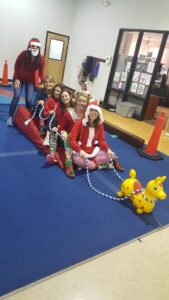“As a child, I loved getting out all our decorations, but especially our holiday books. My parents would pack them away each year, so getting them out for the holiday season made them new and exciting again! We’ve continued this tradition with our kids, adding a new book to the collection each year on the day after Thanksgiving.” – Alison K
“The excitement of getting to open one present on Christmas Eve!” – Amy S.
“I remember having a sleepover with my sister under the Christmas tree on Christmas Eve. We always tried to “catch” Santa, but fell asleep too easily.” -Andrea T.
“My family tradition is a German tradition that we would hide a pickle ornament on our tree at some time on Christmas Eve. The tradition is, that the 1st child to find the pickle got to open 1 gift on Christmas Eve. Well, I have 3 kids, so I ended up having to buy 3 pickles and wrote their names on their pickle so no one got upset that someone got a gift and the other didn’t. My kids are almost all grown now (at 21, 19 & 14), and on Thanksgiving, they still asked if we were “going to do the pickle” this year. Makes my heart smile that they still find this a fun thing to look forward to.” – Ann Marie
“My favorite holiday memory as a kid is waiting on the stairs (impatiently) Christmas morning while my mom went down and made her coffee while checking to see if Santa came. It felt like an eternity!! I now do the same to my boys and they talk about it all the time as well!” Ann T.
“My family is BIG on holiday traditions! Every year, we go downtown to watch “A Christmas Carol” at the Goodman Theatre. It’s a story that never loses it’s magic!” – Jade Pellerito
“My family participates in the Polish tradition of breaking “Oplatki” before Christmas Eve dinner. Each family member breaks off a piece of one another’s wafer and wishes a blessing for the upcoming year.” -Jamie B.
“One of my favorite Holiday Memories, was taking the train with my parents to downtown Chicago and see the Christmas Windows at the stores, and eating lunch at the Walnut Room.
“My other memory was of decorating 2 christmas trees (one upstairs – that had all of the one of a kind, usually breakable ornaments, and Eggshell ornaments that my mom made when pregnant with my brothers). She would blow out the egg and then decorate the shell with scenes inside. We would unwrap the ornaments from their protective coverings, while my dad fought in the corner trying to figure out why the strands of lights weren’t working. The basement tree was usually a real one, and this is the tree that had all of the school and kid made ornaments throughout the years. (4 kids) lots of these ornaments. Now as a parent, My mother still gives each of us (adult couples got glass one of a kind ornaments) and each of the grandkids had an ornament collection started when each grandchild was born. Now as my nieces and nephew move out of their parents houses, they are taking their ornament collections with them and adding them to their own trees. My kids put up my tree every year on the Day after thanksgiving. This with them being in Highschool and College, they did it during the night while I slept. So I had a beautiful tree up when I got up, and then had to clean up all of the ornament boxes and bubble wrap…as they did not put them back in the storage containers.” – Jenn Sparano
“My favorite Christmas holiday tradition is celebrating Wigilia, which is the Polish tradition of celebrating Christmas Eve with a dinner, exchanging presents, and attending Midnight Mass with my family.” – Jess D
“My favorite holiday tradition when I was little was for us to go look at lights and then get an icecream after. I still do it every December!” – Jess K
My favorite holiday tradition is the “Santoro Snack- a- long- Sing- a- long,” when my family packs the house with friends, neighbors, snacks, music, and holiday cheer! My mom hands out sing- along song sheets and instruments borrowed from her kindergarten classroom, and leads the group in song while wearing a microphone head-set! My dad accompanies the shenanigans on the piano. My stomach is guaranteed to hurt from laughing and my face from smiling year after year!” – Kristen S.
“I have loads but one that really stands out for me was helping decorate my Nana’s Snow Village set. She had it all around her house. And we enjoyed looking at the houses and people all lit up. My Nana would also bring my cousins and I out for a holiday tea lunch in Long Grove. We would put on dresses, wear hats, and enjoy tea and little sandwiches. It was so special. She has gifted me some of her Snow Village houses now. I love setting them up (in careful places ofcourse) and watching my kiddos stare and smile at them.” – Maddy C.
“My favorite Holiday tradition is getting together for our annual cookie baking weekend where we bake 10 different types of Holiday cookies, assembling them on a giant plate to eat at the Christmas Eve party.” – Rebecca M.
My favorite holiday tradition is going to church at midnight on Dec 12th with my mom (always hopeful the rest of the family would join us) to celebrate Dia de la Virgen de Guadapule (The day of the Virgin of Guadalupe) who is Mexico’s patron saint. Even on the years I was not able to join my mom, I was involved in a reenactment play of the event and voiced the Virgin’s voice in Spanish and English for the community. – Ruby L.
“My favorite holiday tradition from my childhood was putting up christmas lights outside with my dad on the Sunday after Thanksgiving!” – Shahana
“Every Christmas we participated in a Secret Santa where we secretly chose a name and then left little Christmas gifts at their door. Nobody knew who their secret Santa was until like a week before Christmas. They were some great memories dropping off gifts and trying not to be caught.” – Sheila T.
“My favorite holiday tradition as a kid was always coming home from my grandmas on Christmas Eve to leave out cookies we made for Santa. My favorite tradition as an adult is an ornament exchange between my husband and I we do every year that reminds us of something that happened or we enjoyed throughout the year to look back and reflect on!” -Stephanie C
“My most vivid childhood Christmas memory was when my dad decided to burn the Christmas tree in the family room fireplace! Yep, he thought he’d just slowly keep shoving it further into the fire while it slowly burned but POOF, up it went and we almost needed a NEW house! We teased him EVERY year about this!” – Sue








